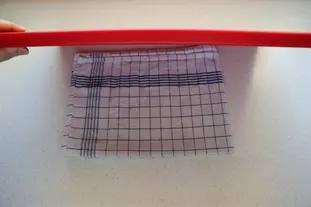A stable cutting board

As soon as you have something to cut in the kitchen, the best thing to do is to use a cutting board, it protects your table or work surface, and their material is made to protect the edge of your knife, that is to say that it is soft enough, in short it is the ideal thing.
But simply put on the work surface, they have an annoying tendency to move.
But simply put on the work surface, they have an annoying tendency to move.
9,598 5/5 (15 reviews)
Keywords for this post:TipTrickMaterialBoardCuttingKnifeLast modified on: May 22th 2021
A stable cutting board
This is especially the case if you have a quality one, but it's sometimes the case for slightly cheaper boards, you've noticed that they don't have legs, they're really "boards", in the sense: a rectangular piece without really a top or bottom.
And as a result, when you put it on your work surface, you have an almost immediate soapy effect, it slides or moves as soon as you start cutting on it, which is quickly a pain in the ass.
How to avoid this ?
Very simple, do as the pros do: Fold a cloth in half and slide it under your board, don't let anything stick out. The cloth acts as a kind of shock absorber that prevents the board from slipping, it remains firmly in place throughout your cuts.
In short: To prevent your cutting board from moving during your cuts, slide a cloth folded in half underneath.
And as a result, when you put it on your work surface, you have an almost immediate soapy effect, it slides or moves as soon as you start cutting on it, which is quickly a pain in the ass.

How to avoid this ?
Very simple, do as the pros do: Fold a cloth in half and slide it under your board, don't let anything stick out. The cloth acts as a kind of shock absorber that prevents the board from slipping, it remains firmly in place throughout your cuts.


In short: To prevent your cutting board from moving during your cuts, slide a cloth folded in half underneath.
Lasts posts
Butter vs. grease
We often read in a recipe where a pastry is put into a mould that, just before pouring, the mould should be buttered or greased. But what's the difference between these 2 terms?December 1st 20251,4815
Getting out of the fridge early
Very often when you're cooking, you need to take food or preparations out of the fridge, to use them in the recipe in progress. There's nothing tricky about this: you just take them out of the fridge and use them, usually immediately, in the recipe. But is this really a good method?November 24th 20251,2855
Who's making the croissants?
When you look at a bakery from the outside, you naturally think that in the bakery, the bakers make the bread, and in the laboratory, the pastry chefs make the cakes. It's very often like that, with each of these professions having quite different ways of working, but sometimes there's also one...November 23th 20251,177
Oven height
When we put a dish or cake in the oven, we naturally tend to put it on the middle shelf, and that's what we usually do. But in some cases, this position and height can be a little tricky, so let's find out why.October 8th 20253,3325
The importance of sieving
In recipes that use a fine powder (flour, powdered sugar, etc.), you'll often see the advice to sift before using it. To sift is to pass the powder in question through a sieve (a very fine strainer) before incorporating it into your recipe. It's often advice, but is it really useful?September 3rd 20257,9443
Other pages you may also like
Beans in primeur
As I write this, it is the beginning of the short season for fresh beans. If you've never made them before and you're just starting out (and that's a great idea) you'll find that it's a bit time consuming to prepare, you have to shell them once, remove the beans, scald them to remove the skin (and...June 4th 202214 K
Cream and sauces
Have you ever wondered why making beautiful tasty sauces is so easy when you use cream? .October 15th 201223 K4.4
Salt and yeast
Let's take a look at an old baker's legend: You may have already read that somewhere in a recipe that uses baker's yeast(bread, pastries, leavened doughs in general) it is often specified "Don't put salt in contact with the yeast, you'll kill it (the yeast)"! Well, that's a belief, and there are...March 15th 201974 K4.3
Should I believe my oven?
Can you really trust your oven? This is an important question as we are always tempted to take the temperature indicated as gospel truth and, unfortunately, this is rarely very precise. .July 4th 201133 K4.6
How to zest a fruit?
You will have no doubt noticed that many recipes call for the zest of citrus fruit. The zest is that outer layer of the skin which adds so much flavour to a dish. There are many different ways to peel off the zest and various tools are available. Here is a summary of the “dos and don'ts” of...November 5th 201347 K3.8
Post a comment or question
Follow this page
If you are interested in this page, you can "follow" it, by entering your email address here. You will then receive a notification immediately each time the page is modified or a new comment is added. Please note that you will need to confirm this following.
Note: We'll never share your e-mail address with anyone else.
Alternatively: you can subscribe to the mailing list of cooling-ez.com , you will receive a e-mail for each new recipe published on the site.









